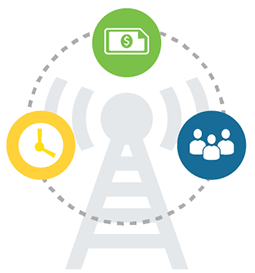
Budgets and resources required to drive employee benefits communication

I rarely encounter a company that couldn’t benefit from communicating more frequently and more intentionally with its employees. Most organizations know their employees need actionable information about how to understand and use their benefits. Still, very few companies have a communications plan in place that supports the universal goal of getting employees better engaged in their benefits. Why? The answer shouldn’t come as a surprise. The biggest impediment to more effective communication is resources—time, people, and money.
If you’re like many of the companies we work with, you know you could be doing more, but you have no idea how to do it with the resources at hand: a limited budget, small team, and an overwhelming list of other responsibilities.
We understand what you’re up against.
Our latest white paper, The value of investing in benefits communication, details how to build a business case, and broadens the conversation to address the value of communications, not just its cost.
Benefits teams absolutely cannot take on any more than they’re already tasked with. Therefore, to get the results your organization needs from its communications, you must increase the capacity and ability of your team to deliver—not just try to stretch what you have now. That typically means taking one of three paths.
- Hiring external experts to support your communications. This could be a specialized agency (like us), an HR consulting or outsourcing firm’s communication practice, a broker/consultant who has a communications practice, or freelancers (there are many who specialize in employee benefits communication). This is often the quickest path to results because you will have expert, dedicated resources who are there to help you succeed.
- Prioritizing internal resources. This could mean allocating your team’s time differently. (Perhaps you can outsource a non-strategic function your team members are doing now to free them up to focus on communications.) Or, it could mean collaborating with your internal communications department to get the needed resources from it. This direction may take more time (and you may still need some outside support), but it could allow you to create an internal team capable of delivering strong year-round communications.
- Leaning on or looking to your vendors. Your vendors—from your administrators to wellness programs to individual plan providers—have a lot to offer for employee communications. You can also explore using point solutions to support communications and engagement. Point solutions are products and services—such as decision-support tools, videos, or interactive experiences—that are designed to solve a very specific problem, and the companies that provide them are enhancing their tools and capabilities all the time. Keep in mind, though, that these solutions need to be integrated into an overall strategy; if your internal resources can help you develop and deploy that strategy, great! If not, consider hiring someone who can. This last approach will require your team to tie together the various pieces to make your communications cohesive, so they reflect your brand and not only those of your vendors.
You may find that a combination of the approaches above works best for you. Employers’ needs—and the ability to support them—vary greatly, depending on their size. Below, we outline the most common resourcing approaches for organizations, by size.
Fewer than 1,000 employees: You’ll need to be scrappy
As an employer with fewer than 1,000 employees, you face unique challenges. It is hard to allocate the resources (people and budget) to develop robust communications, but one-on-one support and in-person meetings may still be possible—and are highly valued by employees. More than likely, you’re not going to be able to establish a dedicated budget for employee benefits communication, and you’ll need to lean on your vendors and internal staff to do as much as you can.
1,000–5,000 employees: Begin making strategic investments
Once your company has grown to several thousand employees, it’s time to invest more in internal communications, including benefits. If you haven’t already, your organization will need to evolve your entire employee communication infrastructure with the right tools and talent to support robust communications that allow your employees and organization to thrive. As organizations grow to this size, they generally create structure around communications with a more formal internal communications team; benefits communication can benefit from that as well. It’s an ideal time to create the case for more resources dedicated to benefits communication. Making key investments early—such as a branded benefits website outside the firewall and a year-round approach—will help preempt challenges down the road. In talent-focused and highly competitive industries like high tech, making those investments early can be critical to recruiting and retention.
5,000–10,000 employees: Dedicate resources to robust communication
At this size, your organization should be investing heavily in internal communication, including benefits communication. If you haven’t already, now is the time to adopt a high-touch, branded, and year-round approach to benefits communication, including a branded website outside the firewall. And be sure to engage employees’ families—as well as employees themselves—in benefits. This will ensure benefits remain a strong part of the employee value proposition, and pave the way for your team to provide consistent, sustainable communication going forward. It’s likely that you’ll primarily use a combination of vendor and external resources, leaning heavily on outside expertise to support your communications. At this size, you will need only a tiny fraction of your overall benefits spend to make a big impact with communication. We often see organizations create tremendous results with less than 1% of their benefits spend dedicated to communication.
More than 10,000 employees: Invest big in robust communication
As an employer with more than 10,000 employees, you should be taking a proactive approach to benefits communication, including making significant investments in highly branded, year-round communication and a robust benefits website that is outside the firewall. This will ensure benefits remain a strong part of the employee value proposition, and pave the way for your team to deliver consistent, sustainable engagement with the breadth of your programs. And you’ll primarily use a combination of vendor and external resources, leaning heavily on outside expertise to support your communications. With more than 10,000 employees, you will need an even smaller fraction of your overall benefits spend to make a huge impact, and you should be able to tie that investment to very specific—and important—business goals.
How do your communications measure up?
No matter the size of your organization, three basic facts prevail: First, communication is worth the investment because benefits improve employee performance and the bottom line, and employees cannot use or appreciate their benefits if they’re not communicated effectively. Second, you will get better results if you have a clear strategy in place. And third, your approach will be unique to you—one size doesn’t fit all when it comes to communicating benefits.
Interested in how your communications measure up? We’d love to talk.
Work with Us
We partner with organizations that value their people first. Let’s talk.

Jennifer Benz, SVP Communications Leader, has been on the leading edge of employee benefits for more than 20 years and is an influential voice in the employee benefits industry.
